A New Strategy to Prevent Emerging Lactococcus garvieae Infections by Using Organic Acids as Antimicrobials In Vitro and Ex Vivo
Abstract
1. Introduction
2. Results
2.1. Bacterial MIC, MBC, Growth Curves, EPS Production, and Biofilm Formation in the Presence of Aq
2.2. The Impact of Aq on the Ability of L. garvieae to Infect CHSE-214 Cells and Reduce Bacteria-Induced Cytotoxicity
2.3. Ex Vivo Effect of Aq in Preventing L. garvieae-Induced Haemolysis in Fish Red Blood Cells (RBCs)
2.4. The Gene Expression of hly1, hly2, and hly3 After Exposure in Culture to 0.125% Aq
3. Discussion
4. Materials and Methods
4.1. CHSE-214 Cell Line and Organic Acid Blend
4.2. Minimum Inhibitory Concentration (MIC), Minimum Bactericidal Concentration (MBC), and Infection Assay
4.3. Growth Curve
4.4. Infection Assay
4.5. Anti-Inflammatory Activity in L. garvieae Infected CHSE-214 in the Presence of 0.5% Aq
4.6. Cytotoxic Lactate Dehydrogenase (LDH) Release Assay
4.7. Exopolysaccharide (EPS) Content Determination, Haemolysin, and Gene Expression
4.8. Haemolysis Assay
4.9. Biofilm Formation in 6-Well Plates
4.10. Statistical Analysis
5. Conclusions
Author Contributions
Funding
Institutional Review Board Statement
Informed Consent Statement
Data Availability Statement
Conflicts of Interest
References
- Heckman, T.I.; Yazdi, Z.; Older, C.E.; Griffin, M.J.; Waldbieser, G.C.; Chow, A.M.; Silva, I.M.; Anenson, K.M.; García, J.C.; LaFrentz, B.R.; et al. Redefining piscine lactococcosis. Appl. Environ. Microbiol. 2024, 90, e0234923. [Google Scholar] [CrossRef]
- Mayo-Yáñez, M.; González-Torres, L. Recurrent Penicillin-Resistant Tonsillitis Due to Lactococcus garvieae, a New Zoonosis from Aquaculture. Zoonotic Dis. 2023, 3, 1–5. [Google Scholar] [CrossRef]
- Sezgin, S.S.; Yılmaz, M.; Arslan, T.; Kubilay, A. Current antibiotic sensitivity of Lactococcus garvieae in rainbow trout (Oncorhynchus mykiss) farms from Southwestern Turkey. J. Agric. Sci. 2023, 29, 630–642. [Google Scholar]
- Khalil, S.M.I.; Orioles, M.; Tomé, P.; Galeotti, M.; Volpatti, D. Current knowledge of lactococcosis in rainbow trout: Pathogenesis, immune response and prevention tools. Aquaculture 2024, 580, 740363. [Google Scholar] [CrossRef]
- Öztürk, R.Ç.; Ustaoglu, D.; Ture, M.; Bondavalli, F.; Colussi, S.; Pastorino, P.; Vela, A.I.; Kotzamanidis, C.; Fernandez-Garayzábal, J.F.; Bitchava, K.; et al. Epidemiological cutoff values and genetic antimicrobial resistance of Lactococcus garvieae and L. Petauri. Aquac. 2024, 593, 741340. [Google Scholar] [CrossRef]
- Eldar, A.; Ghittino, C.; Asanta, L.; Bozzetta, E.; Goria, M.; Prearo, M.; Bercovier, H. Enterococcus serioliciada is a Junior Synonym of Lactococcus garvieae, a Causative Agent of Septicemia and Meningoencephalitis in Fish. Curr. Microbiol. 1996, 32, 85–88. [Google Scholar] [CrossRef] [PubMed]
- Salogni, C.; Bertasio, C.; Accini, A.; Gibelli, L.R.; Pigoli, C.; Susini, F.; Podavini, E.; Scali, F.; Varisco, G.; Alborali, G.L. The Characterisation of Lactococcus garvieae Isolated in an Outbreak of Septicaemic Disease in Farmed Sea Bass (Dicentrarchus labrax, Linnaues 1758) in Italy. Pathogens 2024, 13, 49. [Google Scholar] [CrossRef]
- Araki, K.; Nishiki, I.; Yoshida, T. Characterization and Epidemiological Study of Newly Emerging Lactococcus garvieae Serotype III in Farmed Fish in Japan. Fish Pathol. 2024, 59, 119–126. [Google Scholar]
- Lv, J.; Yang, L.; Li, Y.; Yang, S.; Cai, S.; Jian, J.; Huang, Y. Efficacy of a formalin-inactivated vaccine against Lactococcus garvieae infection in golden pompano Trachinotus ovatus. Isr. J. Aquac. 2023, 75. [Google Scholar] [CrossRef]
- Köse, Ö.; Karabulut, H.; Er, A. Dandelion root extract in trout feed and its effects on the physiological performance of Oncorhynchus mykiss and resistance to Lactococcus garvieae infection. Ann. Anim. Sci. 2024, 24, 161–177. [Google Scholar] [CrossRef]
- Çelik, İ.; Özüsağlam, M.A. Biological Activity of Red Pitahaya Extracts on Lactococcus garvieae and Vibrio alginolyticus. Manas J. Agric. Vet. Life Sci. 2023, 13, 133–139. [Google Scholar] [CrossRef]
- Barbanti, A.C.C.; do Rosário, A.E.C.; da Silva Maia, C.R.M.; Rocha, V.P.; Costa, H.L.; Trindade, J.M.; Nogueira, L.F.F.; Rosa, J.C.C.; Ranzani-Paiva, M.J.T.; Pilarski, F.; et al. Genetic characterization of lactococcosis-causing bacteria isolated from Brazilian native fish species. Aquaculture 2024, 593, 741305. [Google Scholar] [CrossRef]
- Soltani, M.; Naeiji, N.; Zagar, A.; Shohreh, P.; Taherimirghaed, A. Biotyping and serotyping of Lactococcus garvieae isolates in affected farmed rainbow trout (Oncorhynchus mykiss) in north Iran. Iran. J. Fish. Sci. 2021, 20, 1542–1559. [Google Scholar]
- Soltani, M.; Shafiei, S.; Mirzargar, S.S.; Asadi, S. Probiotic, Paraprobiotic, and Postbiotic as an Alternative to Antibiotic Therapy for Lactococcosis in Aquaculture. Iran. J. Vet. Med. 2023, 17, 287–300. [Google Scholar]
- Khalil, S.M.I.; Saccà, E.; Galeotti, M.; Sciuto, S.; Stoppani, N.; Acutis, P.L.; Öztürk, R.C.; Bitchava, K.; Blanco, M.D.M.; Fariano, L.; et al. In field study on immune-genes expression during a lactococcosis outbreak in rainbow trout (Oncorhynchus mykiss). Aquaculture 2023, 574, 739633. [Google Scholar] [CrossRef]
- Akaylı, T.; Ürkü, Ç.; Göken, Z. Pathological aspects of experimental infection of Lactococcus garvieae in European Sea Bass (Dicentrarchus labrax L.): Clinical, hematological, and histopathological parameters. Aquat. Res. 2022, 5, 219–229. [Google Scholar]
- Fichi, G.; Cardeti, G.; Perrucci, S.; Vanni, A.; Cersini, A.; Lenzi, C.; de Wolf, T.; Fronte, B.; Guarducci, M.; Susini, F. Pathogens Associated with Skin Lesions in Octopus vulgaris: First Detection of Photobacterium swingsii, Lactococcus garvieae and Betanodavirus; Unipi: Pisa, Italy, 2015. [Google Scholar]
- Liliana, P.C.; Dumitrescu, G.; McCleery, D.; Pet, I.; Iancu, T.; Stef, L.; Corcionivoschi, N.; Balta, I. Organic acids mitigate Streptococcus agalactiae virulence in Tilapia fish gut primary cells and in a gut infection model. Ir. Vet. J. 2024, 77, 10. [Google Scholar] [CrossRef]
- Corcionivoschi, N.; Balta, I.; McCleery, D.; Pet, I.; Iancu, T.; Julean, C.; Marcu, A.; Stef, L.; Morariu, S. Blends of Organic Acids Are Weaponizing the Host iNOS and Nitric Oxide to Reduce Infection of Piscirickettsia salmonis in vitro. Antioxidants 2024, 13, 542. [Google Scholar] [CrossRef] [PubMed]
- Bunduruș, I.A.; Balta, I.; Butucel, E.; Callaway, T.; Popescu, C.A.; Iancu, T.; Pet, I.; Stef, L.; Corcionivoschi, N. Natural Antimicrobials Block the Host NF-κB Pathway and Reduce Enterocytozoon hepatopenaei Infection Both In Vitro and In Vivo. Pharmaceutics 2023, 15, 1994. [Google Scholar] [CrossRef]
- Pet, I.; Balta, I.; Corcionivoschi, N.; Iancu, T.; Stef, D.; Stef, L.; Cretescu, I. Shrimp White Spot Viral Infections Are Attenuated by Organic Acids by Regulating the Expression of HO-1 Oxygenase and β-1,3-Glucan-Binding Protein. Antioxidants 2025, 14, 89. [Google Scholar] [CrossRef]
- Yilmaz, S.; Ergün, S.; Yilmaz, E.; Ahmadifar, E.; Yousefi, M.; Abdel-Latif, H.M.R. Effects of a phytogenic diet on growth, haemato-immunological parameters, expression of immune- and stress-related genes, and resistance of Oncorhynchus mykiss to Lactococcus garvieae infection. Aquaculture 2024, 587, 740845. [Google Scholar] [CrossRef]
- Kabakci, D.; Ürkü, Ç.; Önalan, Ş. Determination of the antibacterial effect of bee venom against rainbow trout pathogens and antibiotic resistance gene expression. Acta Vet. 2023, 73, 374–388. [Google Scholar]
- Zargar, A.; Ardeshiri, M.; Khosravi, A.; Mirghaed, A.T.; Akbarein, H.; Ahmadpour, M.; Haddadi, A. Study of In-Vitro Antimicrobial Effects of Origanum vulgare and Echinacea purpurea Essential Oils on Lactococcus garvieae. J. Vet. Res. /Majallah-I Taḥqīqāt-I Dāmpizishkī Univ. 2022, 77, 213. [Google Scholar]
- Hassani, F.; Peyghan, R.; Abyavi, T.; Alishahi, M.; Taheri Mirghaed, A. Study of the effect of the essential oil of anise (Pimpinella anisum) on Streptococcus iniae and Lactococcus garvieae isolates identified by PCR. Iran. Vet. J. 2024, 19, 37–46. [Google Scholar]
- Yilmaz, S.; Kenanoğlu, O.N.; Ergün, S.; Çelik, E.Ş.; Gürkan, M.; Mehana, E.E.; Abdel-Latif, H.M.R. Immunological Responses, Expression of Immune-Related Genes, and Disease Resistance of Rainbow Trout (Oncorhynchus mykiss) Fed Diets Supplied with Capsicum (Capsicum annuum) Oleoresin. Animals 2024, 14, 3402. [Google Scholar] [CrossRef] [PubMed]
- Mora-Sánchez, B.; Fuertes, H.; Balcázar, J.L.; Pérez-Sánchez, T. Effect of a multi-citrus extract-based feed additive on the survival of rainbow trout (Oncorhynchus mykiss) following challenge with Lactococcus garvieae. Acta Vet. Scand. 2020, 62, 38. [Google Scholar] [CrossRef]
- Harikrishnan, R.; Devi, G.; Van Doan, H.; Balamurugan, P.; Arockiaraj, J.; Balasundaram, C. Hepatic antioxidant activity, immunomodulation, and pro-anti-inflammatory cytokines manipulation of κ-carrageenan (κ-CGN) in cobia, Rachycentron canadum against Lactococcus garvieae. Fish Shellfish. Immunol. 2021, 119, 128–144. [Google Scholar] [CrossRef]
- Kuo, H.-W.; Li, C.-Y.; Chen, Y.-R.; Cheng, W. The immunostimulatory effects of Theobroma cacao L. pod husk extract via injection and dietary administrations on Macrobrachium rosenbergii and its resistance against Lactococcus garvieae. Fish Shellfish. Immunol. 2023, 132, 108504. [Google Scholar] [CrossRef]
- Kankaya, E.; Önalan, Ş. Immunity-related enzyme gene interactions in Archocentrus centrarchus infected with Lactococcus garvieae. J. Anatol. Environ. Anim. Sci. 2023, 8, 449–455. [Google Scholar]
- Fukada, H.; Senzui, A.; Kimoto, K.; Tsuru, K.; Kiyabu, Y. Evaluation of the in vivo and in vitro interleukin-12 p40 and p35 subunit response in yellowtail (Seriola quinqueradiata) to heat-killed Lactobacillus plantarum strain L-137 (HK L-137) supplementation, and immersion challenge with Lactococcus garvieae. Fish Shellfish. Immunol. Rep. 2023, 4, 100095. [Google Scholar] [CrossRef]
- Akmal, M.; Nishiki, I.; Zrelovs, N.; Yoshida, T. Complete genome sequence of a novel lytic bacteriophage, PLG-II, specific for Lactococcus garvieae serotype II strains that are pathogenic to fish. Arch. Virol. 2022, 167, 2331–2335. [Google Scholar] [CrossRef] [PubMed]
- Muhammad, A. Isolation and Genetic Characterization of Lytic Bacteriophages Infecting Bacterial Fish Pathogens and Drug Resistance Mechanisms in Lactococcus garvieae Serotype II. Ph.D. Thesis, The University of Miyazaki, Miyazaki, Japan.
- Hussein, M.M.A.; Hassan, W.H.; Yassen, H.A.; Osman, A.M.A. Vaccination with bacterial ghosts of Streptococcus iniae and Lactococcus garvieae originated from outbreak of marine fish streptococcosis, induce potential protection against the disease in Nile tilapia, Oreochromis niloticus (Linnaeus, 1758). Fish Shellfish. Immunol. 2023, 141, 109008. [Google Scholar] [CrossRef]
- Ali, W.; Chen, Y.; Wang, Z.; Yan, K.; Men, Y.; Li, Z.; Cai, W.; He, Y.; Qi, J. Characterization of antimicrobial properties of TroH2A-29 peptide from golden pompano (Trachinotus ovatus). Dev. Comp. Immunol. 2025, 163, 105315. [Google Scholar] [CrossRef]
- Sufiara, Y.; Rahul, S. Analysis of the ability of Channa striatus gut-derived Lactococcus garvieae bacteria to reach and persist in the gut environment along with extracellular metabolites and its behavior against common fish pathogens. Res. J. Biotechnol. Vol. 2023, 18, 9. [Google Scholar]
- Xie, X.; Pan, Z.; Yu, Y.; Yu, L.; Wu, F.; Dong, J.; Wang, T.; Li, L. Prevalence, Virulence, and Antibiotics Gene Profiles in Lactococcus garvieae Isolated from Cows with Clinical Mastitis in China. Microorganisms 2023, 11, 379. [Google Scholar] [CrossRef] [PubMed]
- Majeed, S.; De Silva, L.A.D.S.; Kumarage, P.M.; Heo, G.-J. Characterization of pathogenic Lactococcus garvieae isolated from farmed mullet (Mugil cephalus). Vet. Integr. Sci. 2025, 23, 1–17. [Google Scholar] [CrossRef]
- Xu, R.; He, Z.; Deng, Y.; Cen, Y.; Mo, Z.; Dan, X.; Li, Y. Lactococcus garvieae as a Novel Pathogen in Cultured Pufferfish (Takifugu obscurus) in China. Fishes 2024, 9, 406. [Google Scholar] [CrossRef]
- Feito, J.; Araújo, C.; Gómez-Sala, B.; Contente, D.; Campanero, C.; Arbulu, S.; Saralegui, C.; Peña, N.; Muñoz-Atienza, E.; Borrero, J.; et al. Antimicrobial activity, molecular typing and in vitro safety assessment of Lactococcus garvieae isolates from healthy cultured rainbow trout (Oncorhynchus mykiss, Walbaum) and rearing environment. LWT 2022, 162, 113496. [Google Scholar] [CrossRef]
- Shahi, N.; Mallik, S.K. Emerging bacterial fish pathogen Lactococcus garvieae RTCLI04, isolated from rainbow trout (Oncorhynchus mykiss): Genomic features and comparative genomics. Microb. Pathog. 2020, 147, 104368. [Google Scholar] [CrossRef]
- Kawanishi, M.; Yoshida, T.; Yagashiro, S.; Kijima, M.; Yagyu, K.; Nakai, T.; Murakami, M.; Morita, H.; Suzuki, S. Differences between Lactococcus garvieae isolated from the genus Seriola in Japan and those isolated from other animals (trout, terrestrial animals from Europe) with regard to pathogenicity, phage susceptibility and genetic characterization. J. Appl. Microbiol. 2006, 101, 496–504. [Google Scholar] [CrossRef]
- Teker, T.; Albayrak, G.; Akayli, T.; Urku, C. Detection of haemolysin genes as genetic determinants of virulence in Lactococcus garvieae. Turk. J. Fish. Aquat. Sci. 2019, 19, 625–634. [Google Scholar]
- Oerlemans, M.M.P.; Akkerman, R.; Ferrari, M.; Walvoort, M.T.C.; de Vos, P. Benefits of bacteria-derived exopolysaccharides on gastrointestinal microbiota, immunity and health. J. Funct. Foods 2021, 76, 104289. [Google Scholar] [CrossRef]
- Kaur, N.; Dey, P. Bacterial exopolysaccharides as emerging bioactive macromolecules: From fundamentals to applications. Res. Microbiol. 2023, 174, 104024. [Google Scholar] [CrossRef]
- Gao, K.; Su, B.; Dai, J.; Li, P.; Wang, R.; Yang, X. Anti-Biofilm and Anti-Hemolysis Activities of 10-Hydroxy-2-decenoic Acid against Staphylococcus aureus. Molecules 2022, 27, 1485. [Google Scholar] [CrossRef] [PubMed]
- Cho, H.S.; Lee, J.-H.; Cho, M.H.; Lee, J. Red wines and flavonoids diminish Staphylococcus aureus virulence with anti-biofilm and anti-hemolytic activities. Biofouling 2015, 31, 1–11. [Google Scholar] [CrossRef]
- Gao, X.; Liu, J.; Li, B.; Xie, J. Antibacterial Activity and Antibacterial Mechanism of Lemon Verbena Essential Oil. Molecules 2023, 28, 3102. [Google Scholar] [CrossRef]
- Eldar, A.; Bejerano, Y.; Livoff, A.; Horovitcz, A.; Bercovier, H. Experimental streptococcal meningo-encephalitis in cultured fish. Vet. Microbiol. 1995, 43, 33–40. [Google Scholar] [CrossRef]
- Vendrell, D.; Balcázar, J.L.; Ruiz-Zarzuela, I.; de Blas, I.; Gironés, O.; Múzquiz, J.L. Lactococcus garvieae in fish: A review. Comp. Immunol. Microbiol. Infect. Dis. 2006, 29, 177–198. [Google Scholar] [CrossRef]
- Thakur, P.; Chawla, R.; Narula, A.; Goel, R.; Arora, R.; Sharma, R.K. Anti-hemolytic, hemagglutination inhibition and bacterial membrane disruptive properties of selected herbal extracts attenuate virulence of Carbapenem Resistant Escherichia coli. Microb. Pathog. 2016, 95, 133–141. [Google Scholar] [CrossRef]
- Kumar, G.; Karthik, L.; Venkata, K.; Rao, B. Haemolytic activity of Indian medicinal plants toward human erythrocytes: An in vitro study. Appl. Bot. 2011, 40, e5537. [Google Scholar]
- Ghirmai, S.; Wu, H.; Axelsson, M.; Matsuhira, T.; Sakai, H.; Undeland, I. Exploring how plasma- and muscle-related parameters affect trout hemolysis as a route to prevent hemoglobin-mediated lipid oxidation of fish muscle. Sci. Rep. 2022, 12, 13446. [Google Scholar] [CrossRef]
- Bulfon, C.; Prearo, M.; Volpatti, D.; Byadgi, O.; Righetti, M.; Maniaci, M.G.; Campia, V.; Pastorino, P.; Pascoli, F.; Toffan, A.; et al. Resistant and susceptible rainbow trout (Oncorhynchus mykiss) lines show distinctive immune response to Lactococcus garvieae. Fish Shellfish. Immunol. 2020, 105, 457–468. [Google Scholar] [CrossRef] [PubMed]
- Zou, J.; Secombes, C.J. The Function of Fish Cytokines. Biology 2016, 5, 23. [Google Scholar] [CrossRef] [PubMed]
- Pinkerton, L.; Linton, M.; Kelly, C.; Ward, P.; Gradisteanu Pircalabioru, G.; Pet, I. Attenuation of vibrio parahaemolyticus virulence factors by a mixture of natural antimicrobials. Microorganisms 2019, 7, 679. [Google Scholar] [CrossRef]
- Stratakos, A.C.; Linton, M.; Ward, P.; Campbell, M.; Kelly, C.; Pinkerton, L. The antimicrobial effect of a commercial mixture of natural antimicrobials against Escherichia coli O157:H7. Foodborne. Pathog. Dis. 2019, 16, 119–129. [Google Scholar] [CrossRef]
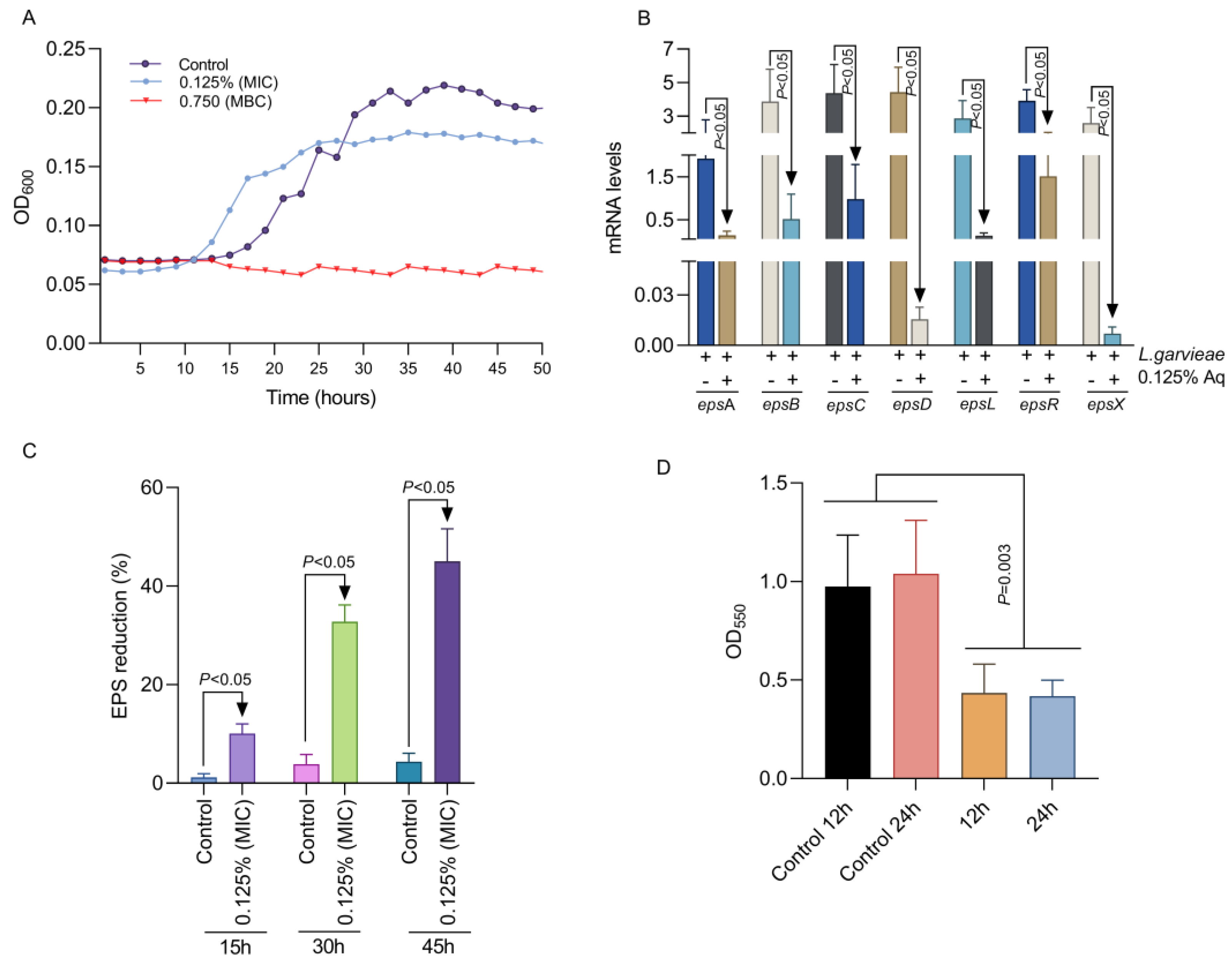
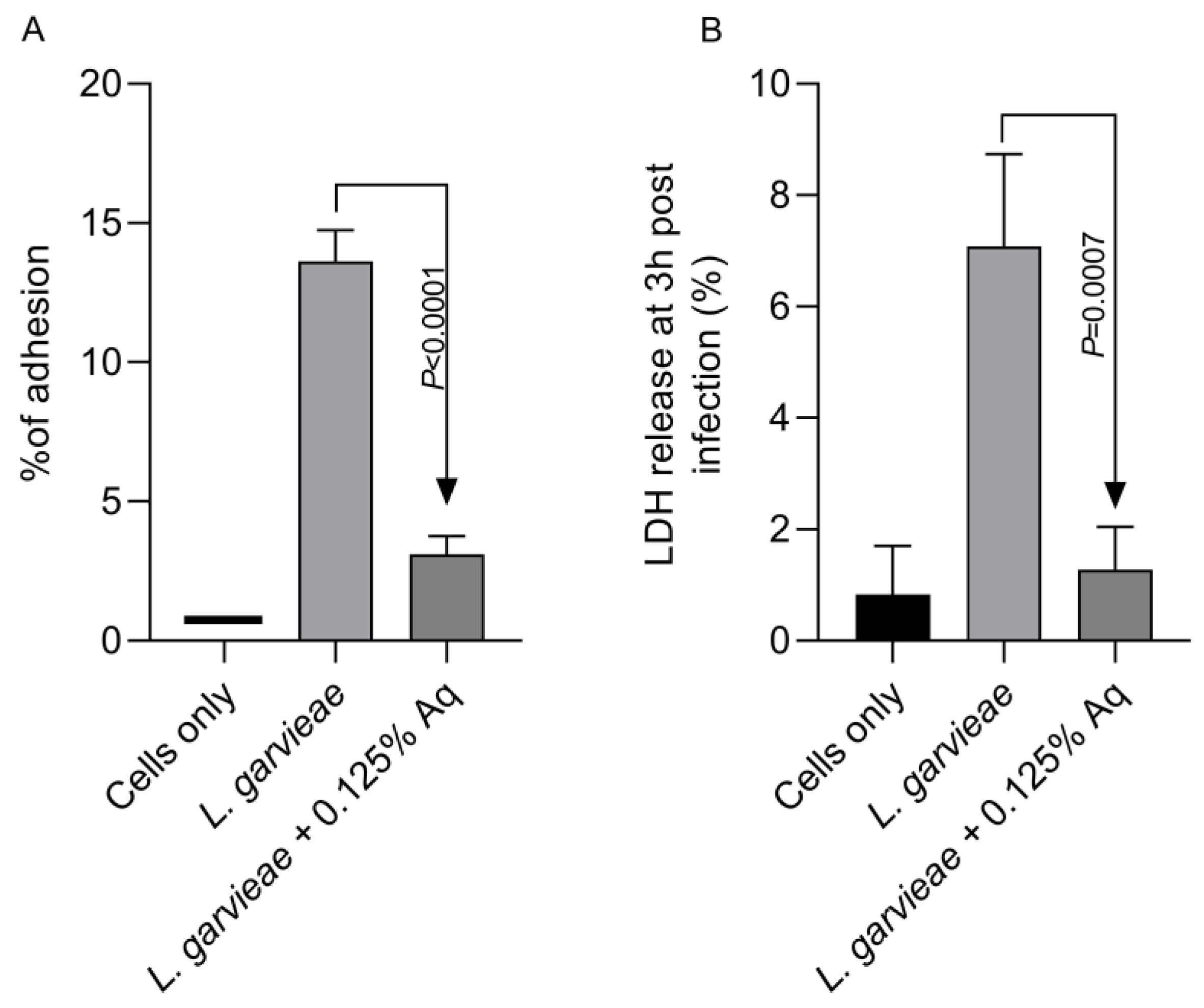
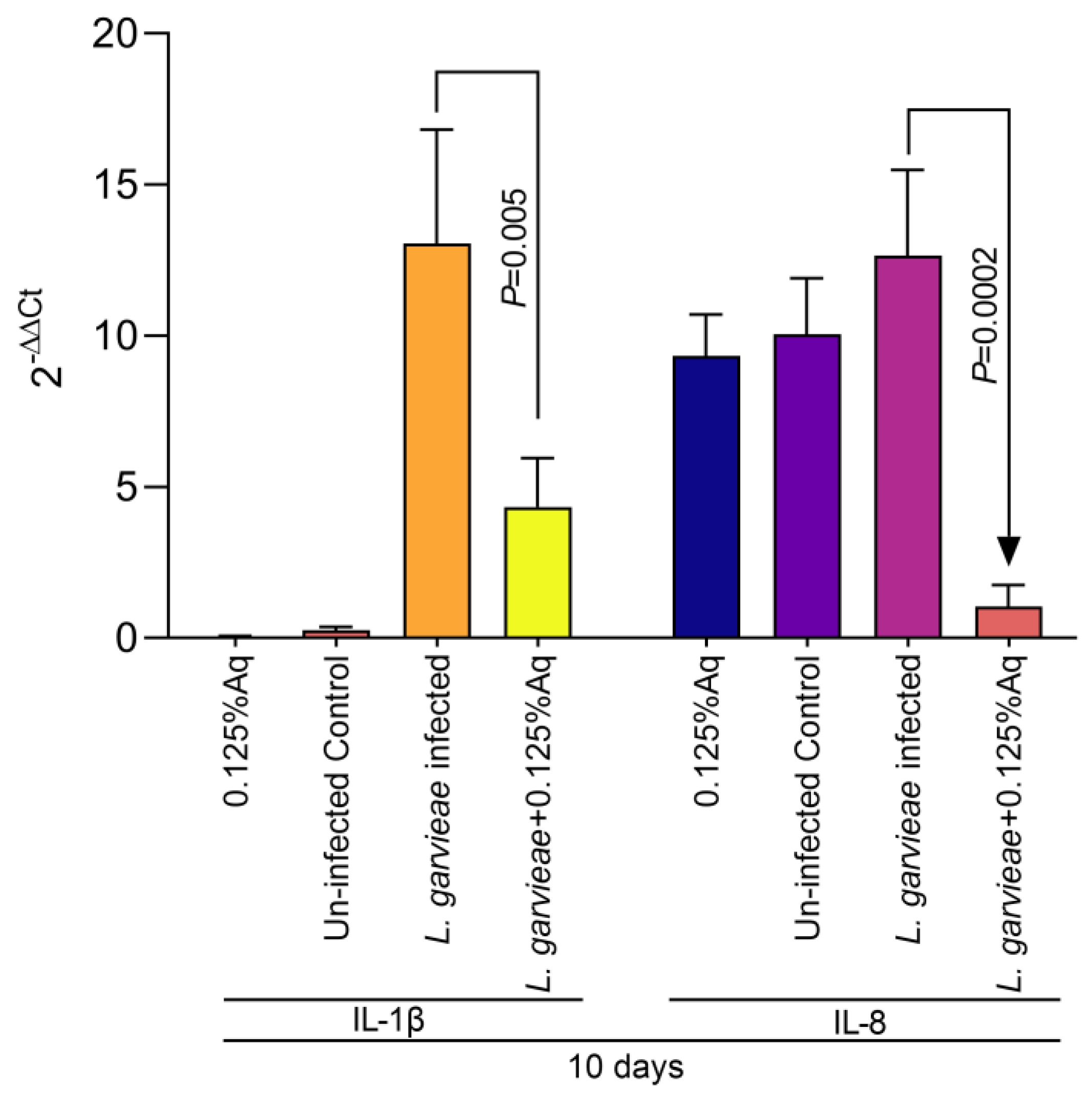
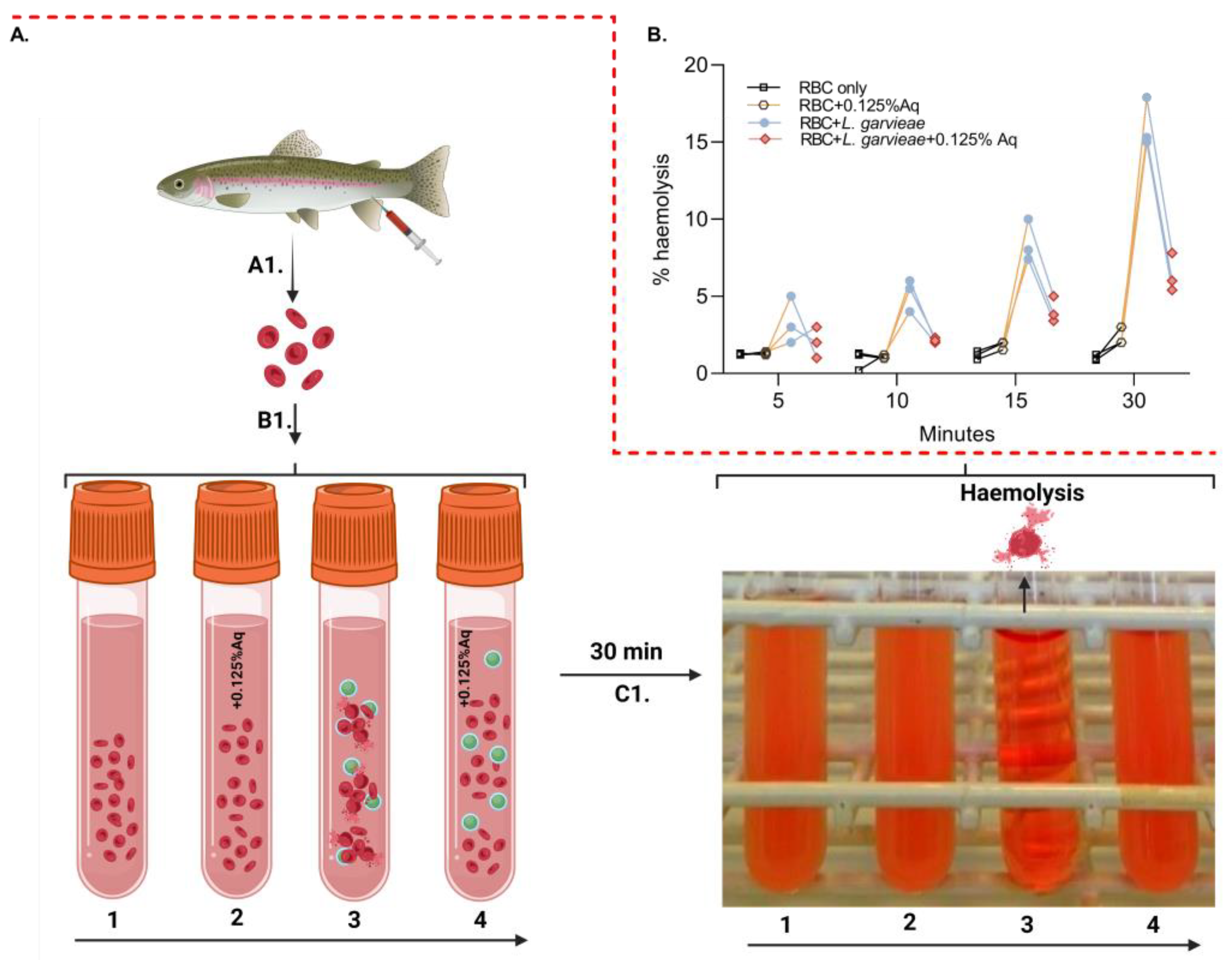
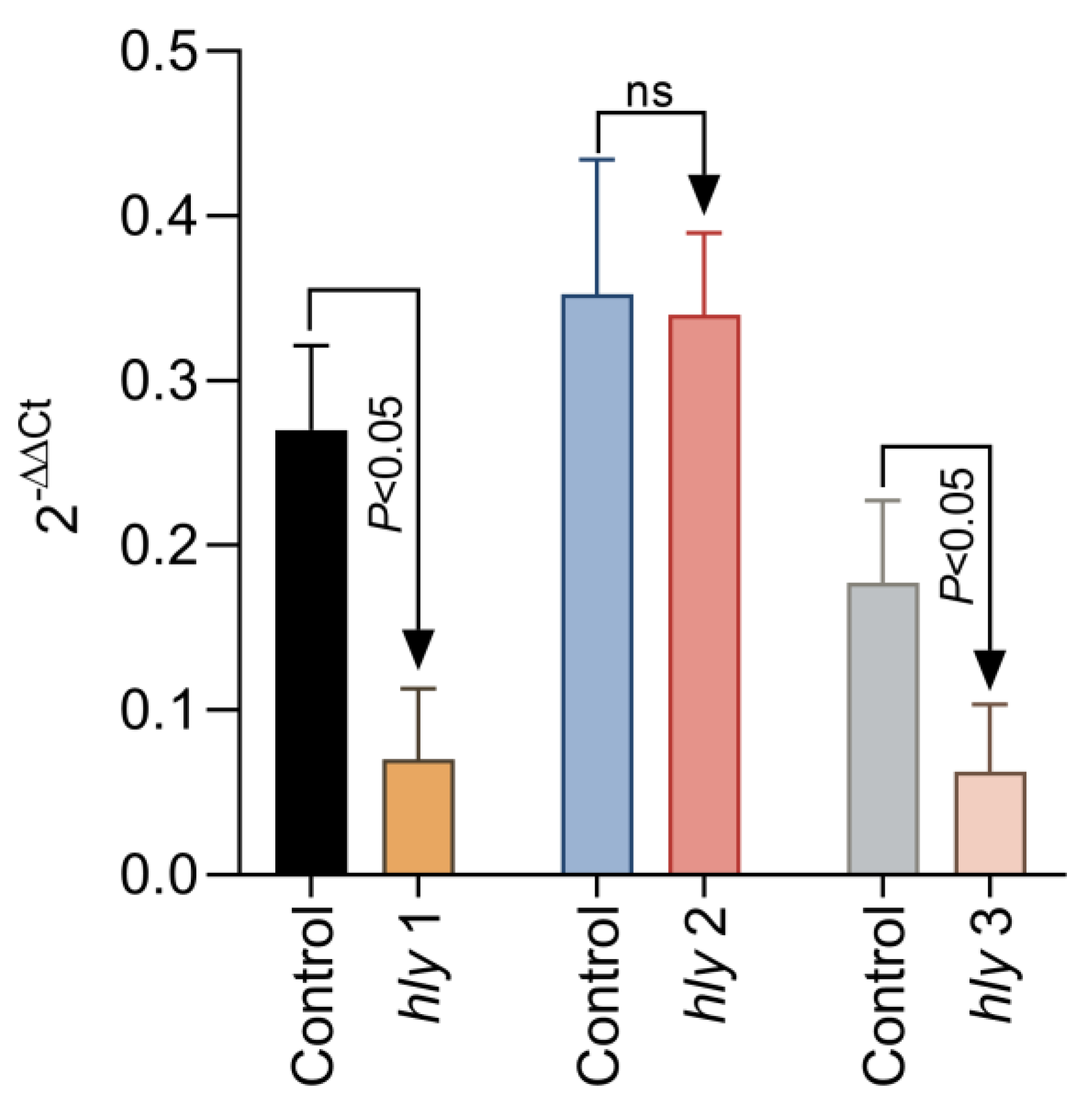

| epsA | F-TTATAGCCTCCCCAGTTTACAC R-TTTAGCAGTCTCGTCTGCAATC |
| epsB | F-CGCAAGTGCTAATCTAGCTG R-AGAGAGGCGGAGTATCAATC |
| epsC | F-TAACAACTATCACTGCGACTCC R-TCAGGGTTCTCAATGATTCCAC |
| epsD | F-TTTCTTATTGCGGCTGCATTGC R-CTCATCAATTGAGTGTCGTCTG |
| epsL | F-ACCAATCGTACAGATCAACG R-CTTGAGCCACCACTATCAAG |
| epsR | F-TTTTACCACCGGCTAAAGGAAC R-TTGCAGAACTGTCATTAGGCTC |
| epsX | F-TATTGAAGCAACAGCCTCACTG R-TTTTTGTCTGGGTAACTAGCCC |
| 30S rRNA | F-TACGAACACCGTATCCTTGAC R-TTGTGTTGGTTCGATGATGTCG |
| hly1 | F-TCCTCCGACTAGGAACCAAA R-GCCAGCTTCTCGTGCTTATC |
| hly2 | F-GAGCAAAAAGCGAGTGAAGG R-GCATCTGGAGCATCAAGTCA |
| hly3 | F-CGTGGAGTTATGGCTGGTTT R-CTTGTGGATCTTCGGGTCTT |
Disclaimer/Publisher’s Note: The statements, opinions and data contained in all publications are solely those of the individual author(s) and contributor(s) and not of MDPI and/or the editor(s). MDPI and/or the editor(s) disclaim responsibility for any injury to people or property resulting from any ideas, methods, instructions or products referred to in the content. |
© 2025 by the authors. Licensee MDPI, Basel, Switzerland. This article is an open access article distributed under the terms and conditions of the Creative Commons Attribution (CC BY) license (https://creativecommons.org/licenses/by/4.0/).
Share and Cite
Balta, I.; Simiz, F.D.; Stef, D.; Pet, I.; Dumitrescu, G.; Iancu, T.; Cretescu, I.; Corcionivoschi, N.; Stef, L. A New Strategy to Prevent Emerging Lactococcus garvieae Infections by Using Organic Acids as Antimicrobials In Vitro and Ex Vivo. Int. J. Mol. Sci. 2025, 26, 3423. https://doi.org/10.3390/ijms26073423
Balta I, Simiz FD, Stef D, Pet I, Dumitrescu G, Iancu T, Cretescu I, Corcionivoschi N, Stef L. A New Strategy to Prevent Emerging Lactococcus garvieae Infections by Using Organic Acids as Antimicrobials In Vitro and Ex Vivo. International Journal of Molecular Sciences. 2025; 26(7):3423. https://doi.org/10.3390/ijms26073423
Chicago/Turabian StyleBalta, Igori, Florin Dan Simiz, Ducu Stef, Ioan Pet, Gabi Dumitrescu, Tiberiu Iancu, Iuliana Cretescu, Nicolae Corcionivoschi, and Lavinia Stef. 2025. "A New Strategy to Prevent Emerging Lactococcus garvieae Infections by Using Organic Acids as Antimicrobials In Vitro and Ex Vivo" International Journal of Molecular Sciences 26, no. 7: 3423. https://doi.org/10.3390/ijms26073423
APA StyleBalta, I., Simiz, F. D., Stef, D., Pet, I., Dumitrescu, G., Iancu, T., Cretescu, I., Corcionivoschi, N., & Stef, L. (2025). A New Strategy to Prevent Emerging Lactococcus garvieae Infections by Using Organic Acids as Antimicrobials In Vitro and Ex Vivo. International Journal of Molecular Sciences, 26(7), 3423. https://doi.org/10.3390/ijms26073423









